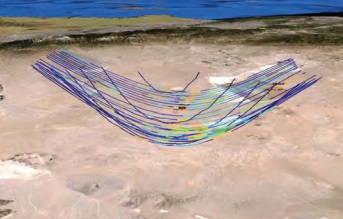Chapter: Supersonic Flight Research, new invention technology, Research project papers,
Cockpit Interactive Sonic Boom Display Avionics (CISBoomDA)

Cockpit Interactive Sonic Boom Display
Avionics (CISBoomDA)
CISBoomDA is a
real-time, interactive sonic boom display that enables pilots to control the
location and intensity of sonic booms. The system can be integrated into any
cockpit or flight control room to help pilots place loud booms in specific
locations away from populated areas, ensure that quiet booms are produced in
these areas, or prevent sonic booms from occurring at all. This patented
technology processes vehicle and flight parameters as well as data regarding
current atmospheric conditions. The prediction data are integrated with a
local-area moving-map display that is capable of displaying in real time the
aircraft's current sonic boom footprint, enabling pilots to make necessary
flight adjustments to control them.
Work to date: This proven technology has been operating in
Armstrong control rooms and simulators since 2000 and has aided
several sonic boom research projects.
Looking ahead: The research team is
preparing an F/A-18 plane for flight testing. The two-seat aircraft
will allow 'guest pilots' and/or
passengers from the
FAA and avionics firms to observe the CISBoomDa technology in action. Also in
development is a portable simulation device that could be used to demonstrate
the technology to avionics firms. A solicitation for work on this display was posted
in mid 2014 on the NASA Solicitation and Proposal Integrated Review and
Evaluation System (NSPIRES) website.
Benefits
Enables overland supersonic travel:
Because
pilots can control the location and intensity of sonic booms, CISBoomDA will
allow future-generation supersonic aircraft to fly over land.
Reduces noise pollution: CISBoomDA allows
for appropriate placement of booms, minimizing their effects on the ground.
Supersonic Flight Research
Supersonic flight over land is currently severely restricted
because sonic booms created by shock waves disturb people on the ground and can
damage private property. Since the maximum loudness of a sonic boom is not
specifically defined by the current Federal Aviation Administration (FAA)
regulation, innovators at NASA have been researching ways to identify a
loudness level that is acceptable to both the FAA and the public and to reduce
the noise created by supersonic aircraft. Using cutting-edge testing that
builds on previous supersonic research, NASA is exploring low-boom aircraft
designs and other strategies that show promise for reducing sonic boom levels.
A variety of factors, from the shape and position of aircraft
components to the propulsion system's characteristics, determine the make-up of
a supersonic aircraft's sonic boom.
Related Topics